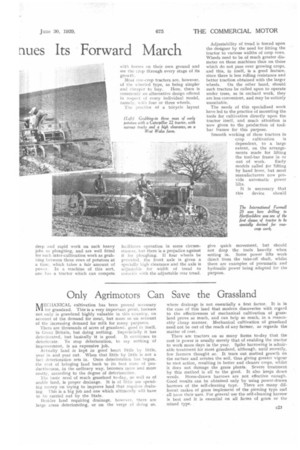The Row-crop Tractor C( nues Its Forward March
Page 62

Page 63

If you've noticed an error in this article please click here to report it so we can fix it.
Much Progress is Being Made by a Class of Machine Which is Fast Ousting the Horse for the Inter-cultivation of Crops
Grown in Rous
FOR many years it has been one of the arguments advanced by horse enthusiasts against the tractor that. there were many jobs which could not be done with a tractor and for which horses were essential. Therefore, if one had to keep some horses there was no object in a farmer having a tractor at all. Chief among the jobs cited as jobs for the horse was the inter-cultivation of crops grown in rows, such as potatoes, mangolds and sugar beet.
The argument was, in part, a sound one, although far from being completely true. Many people derive good results from the combined efforts of tractor and horses. Nevertheless, many others have, all along, wanted to see their row-crop work clone with mechanical power, and the tractor designer has had to plan a versatile machine to fill the bill.
There is no doubt of the success of his efforts. The row-crop class has become so well established that it is considerably altering the complexion of this branch of farming. The machines on offer to-day for row-crop work are capable of carrying out all that is required of them, not only in the way of inter-cultivation, but practically any work that a standard type may be set to do.
Row-crop tractors are built in several different styles. There is a number of different British machines for this work, these being mounted on tracks. The smallest of them, the Ransomes motor cultivator, mounts a little power trait of only 6 h.p. It is finding a place on some of the biggest farms in the country for the purpose of hoeing large acreages of root crops, etc., in which one operator can do many times as much work in a day as two workers with a horse hoe.
Some of the American crawler tractors, such as the Caterpillar, with power units of between 20 b.h.p. and 30 b.h.p. are built with special tracks and high clearance and come into the row-crop class. These are, of course, capable of
deep and rapid work on such heavy jobs as ploughing, and are well fitted for such inter-cultivation work as grubbing between three rows of potatoes at a time, which takes a fair amount of power. In a machine of this sort, one has a tractor which can compete with horses on their own ground and see the crop through every stage of its growth.
Most row-crop tractors are, however, of the wheeled type, as being simpler
and cheaper to buy. Here, there is commonly an alternative design offered in respect of every individual model, namely, with four or three wheels.
The practice of a tricycle layout
facilitates operation in some circumstances, hut there is a prejudice against it for ploughing. If four wheels be provided, the front axle is given a specially high clearance and the axle is adjustable for width of tread to coincide with the adjustable rear tread.
Adjustability of tread is forced upon the designer by the need for fitting the tractor to various widths of crop rows. Wheels need to be of much greater diameter on these machines than on those which do not pass over growing crops, and this, in itself, is a good feature, since there is less rolling resistance and better traction obtained with the larger wheels. On the other hand, should such tractors be called upon to operate under trees, as in orchard work, they are less convenient, and may be entirely unsuitable.
The needs of this specialized work have led to the practice of mounting the tools for cultivation directly upon the tractor itself, and much attention is now given to the production of toolbar frames for this purpose.
Smooth working of these tractors in crop cultivation is dependent, to a large extent, on the arrangements made for lifting the tool-bar frame in or out of work. Early models called for lifting by hand lever, but most manufacturers now provide automatic power lifts.
It is necessary that this device should
give quick movement, but should not drop the taols heavily when setting in. Some power lifts work direct from the take-off shaft, whilst there are examples of pneumatic and hydraulic power being adapted for the purpose.




































































































































